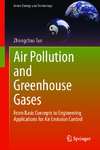| dc.description.abstract | Air emissions include air pollution emissions and greenhouse gas emissions.
Effective air emission control requires multidisciplinary expertise in engineering,
education, physics, chemistry, mathematics, medical science, psychology, agriculture,
architecture, business management, economics, and politics. It is a difficult
task for the author(s) of any single book to address all aspects of air emissions. The
focus of this book is on engineering science and technology, upon which effective
air emission control program must be built. It does not prescribe social, economic,
and political factors that lie outside the scope of this book.
This book aims at senior undergraduate and graduate students with educational
backgrounds in mechanical, chemical, and/or environmental engineering. It can
also be used by professionals with similar training background. It focuses on the
basic concepts and engineering applications of technologies for the control of air
emissions resulted from fossil fuel combustion.
This book is divided into three parts. The general basic concepts introduced in
Part I are necessary to the understanding of air emission engineering topics in Parts
II and III. Part II presents the engineering applications of the principles introduced
in Part I. Part III covers some emerging topics related to air emission engineering
and they include carbon capture and storage, nanoaerosol, indoor air quality.
Following a brief introduction to air emission in Chap. 1, Chaps. 2–4 present the
general basic properties of gases and aerosol particles. They are necessary to
understand the formation and behavior of air emissions. Chapters 5 and 6 present
basic principles for the separation of unwanted gases and particulates from the
contaminated air. These are the principles for the related engineering applications in
Parts II and III such as syngas cleaning, carbon capture, and flue gas cleaning.
Part II of the book introduces the strategies for precombustion (Chaps. 7 and 8),
in-combustion (Chap. 9) and postcombustion (Chap. 10) air emission control, step
by step, from a process point of view. While air dispersion model (Chap. 11) is a
powerful tool for air quality assessment and impact prediction, air dispersion itself
is also a measure for air emission control by dilution. | en_US |

